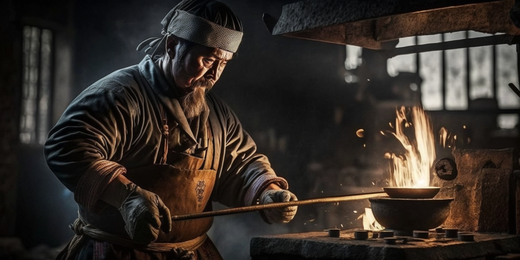Japanese Samurai Swords Forging Process

The art of Japanese swordsmithing is a meticulous and ancient craft that transforms raw materials into a weapon of beauty and strength. The process begins with selecting the right type of steel, often high carbon steel for its durability and sharpness. The swordsmith uses iron sand, which is refined to create the unique jewel steel that gives the blade its distinctive qualities.
To begin the forging, the swordsmith heats, hammers, and folds the steel repeatedly. This process strengthens the metal, allowing it to withstand battle while maintaining flexibility—a vital characteristic of a samurai sword that allows it to bend without breaking. Afterward, the grinding and polishing stage begins. A sword polisher carefully sharpens the blade to a fine edge, ensuring both precision and balance.
Lastly, the handle wrapping is done with great care to provide a secure and comfortable grip, ensuring that the sword is as functional as it is beautiful. The result is a masterfully crafted samurai sword, created through a combination of traditional techniques and the swordsmith's expertise. This intricate making of a samurai sword creates a blade that embodies the essence of Japanese craftsmanship and the warrior spirit.
cooling scope wukong
Since ancient times, as a weapon, it has been known for its graceful shape. Many famous knives have been collected as works of art, and they contain the symbolic meaning of the soul of a samurai. Different from knives in other countries, one of the biggest features of Japanese samurai swords is that the knife body itself shows an artistic sense in addition to the appearance decoration. In Japan, knife makers are called 'sword workers', 'sword craftsmen' or 'sword blacksmiths'.
The cooling scope in the Japanese samurai swords forging process is a critical step where the blade is carefully cooled, ensuring the perfect balance of hardness and flexibility. This stage, akin to a cooling slope, involves precise temperature control to prevent any rusty gold discoloration that could compromise the sword's appearance and function. In the field of fire, where the sword's blade is heated to extreme temperatures, the craftsmanship of the swordsmith is put to the test. Hidden within the secret area of the forge, techniques passed down through generations are applied to create the perfect katana, blending artistry and practicality. Each step, from the initial forging to the cooling process, contributes to the legendary quality of the samurai sword, making it not just a weapon, but a work of art.
1. The method of making samurai swords in Japan
Japanese samurai swords have assembled quite high technology in the manufacturing method, and the material steel of Japanese samurai swords is called Hegang, or jade steel. Jade steel is made by traditional Japanese methods. This is a low-temperature steelmaking method where the furnace temperature does not exceed 1000°C. This method may seem primitive, but compared with the modern high-temperature steelmaking method, it can produce high-quality and pure steel. However, the steel produced at high temperature is softer and easy to form, while the steel produced at low temperature is harder and more difficult to form. It can be said that the production of Japanese samurai swords is a labor-intensive fortification, and the quality is paid for by blood and sweat.
According to different regions and different genres, the composition of the steel used will vary. In addition, the process of water reduction is quenching. From the perspective of modern material science, this step can be regarded as a method for swordsmiths to control the carbon content of steel. The seemingly simple process is actually not the case. In order to control the carbon content of the steel, the heating times are strictly limited; and the hardness of the steel will change as it gradually cools. Under the limited heating times, the jade steel is beaten into thin slices with uniform thickness. After the steel sheet is formed, the knife maker will rapidly cool it with water. The excess carbon-containing part of the steel can be stripped. Make the knife body have good elasticity, and the knife edge is hard and not easy to chip. The knifemaker must have an extremely accurate grasp of the temperature of the steel sheet and the amount of water used to obtain materials with a suitable carbon content.
When tempering the knife material, the knife worker beats the red-hot steel block for forging, the steel block is opened and then folded and beaten, and so on, until the 10th time, there will be 1024 layers of steel. Through this step, impurities such as sulfur and excess carbon in the steel can be removed to enhance the elasticity and toughness of the steel. This is like kneading dough. The more layers of beating, the more uniform the carbon and various components in the steel, and the finer the iron crystals. The final forged steel is of uniform quality, with thousands of layers, and is very strong. .
2. Japanese samurai swords steel matching
The shape of Japanese samurai swords is based on a circle, regardless of the tip or the entire blade. The reason why the blade is curved is mainly caused by the combination of steel and quenching. First of all, the knife craftsman uses the hard blade metal and leather iron with high carbon content to wrap the soft core iron with low carbon content. This double structure is a major feature of Japanese samurai swords. The edge metal and leather iron on the outside make the knife sharp and have proper hardness so as not to bend. In the subsequent firing stage, the difference in volume expansion between the tip of the blade and other parts is controlled by the amount of carbon and the cooling rate of the firing. As a result, strong compressive stress is generated on the tip of the knife, making the knife less prone to breakage and forming the curvature of a machete.
3. The last fire forging process of Japanese samurai swords is also called burning the blade with soil
The process is probably that black katana knife workers first use clay, charcoal powder and whetstone powder to prepare burnt blade soil, and then encapsulate the shaped blade with burnt blade soil. The soil used for blades is thinner, and the soil used for picks and ridges is thicker. Basically, the distribution of burnt clay can be seen from the blade text of the finished product, and the composition and preparation methods of different schools of burnt clay are also different. The sealed blade will be put into the fire at 750℃-760℃. Knife workers judge the temperature in the furnace by the color of the flame based on experience. If the temperature exceeds 800°C, it will affect the strength of the knife. After a specific heating time, the knifemaker will put the knife in the water to cool it rapidly, and carry out another quenching process.
After the above steps are completed, the work of the black katana knife worker has reached a stage, and the grinding, sheath making, decoration, handle rolling and other processes will be handled by a special person, which is not within the scope of work of the knife worker.
